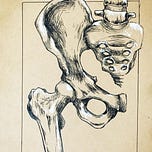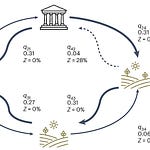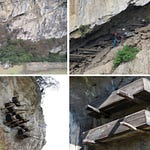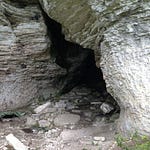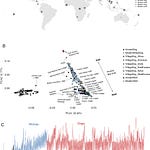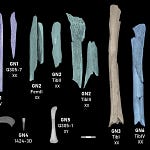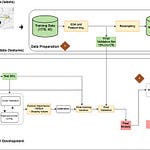When our ancestors first stood upright, they didn’t just change how they moved. They rewired the very blueprint of their skeletons. Among the most radical changes was the pelvis—an anchor point for muscle, balance, and birth. For decades, anthropologists have tried to piece together how a structure built for climbing turned into the basin-shaped platform of a biped.
A new study in Nature1 dives into that mystery with a combination of embryology, genetics, and evolutionary biology. The researchers conclude that the human pelvis didn’t simply shorten or widen through gradual tweaks. Instead, it underwent two profound shifts—changes that set the stage for walking, running, and eventually the birth of large-brained babies.
The Pelvis Problem
Among primates, the human pelvis is an anomaly. In chimpanzees and gorillas, the hip bones—the ilia—are tall and blade-like, perfect for anchoring climbing muscles. In humans, those same bones flare outward to the sides, forming a bowl. This bowl supports the internal organs when standing upright and provides attachment points for the muscles that stabilize the body during bipedal locomotion.
“How the pelvis got that way has always been a central question,” said Terence Capellini, senior author of the study and a professor of human evolutionary biology at Harvard.
A Tale in Two Moves
By analyzing more than 120 embryonic specimens from humans and other primates, along with advanced imaging and molecular techniques, the team identified two key evolutionary changes.
The first was a dramatic reorientation of a growth plate in the ilium. In early development, human embryos start with growth plates aligned head-to-tail—just like other primates. But by the seventh week, something unusual happens: the plate rotates 90 degrees. This rotation shifts growth outward instead of upward, making the bone short and broad rather than tall and narrow.
“The histology really revealed that it actually flipped 90 degrees—making it short and wide all at the same time,” said Capellini.
The second change was in timing. Bone formation in humans—ossification—starts later and spreads differently compared to other primates. Instead of hardening from the center outward, ossification in the ilium begins near the sacrum and radiates toward the edges, while the core stays soft for longer. This delay allows the pelvis to maintain its flared shape during growth.
Genes Behind the Shift
What drove these changes? The researchers identified over 300 genes involved, but three stood out: SOX9 and PTH1R, which control the growth plate rotation, and RUNX2, which affects ossification timing. Mutations in these genes in modern humans cause disorders that dramatically alter hip shape, underscoring their importance in pelvic development.
“These genetic pathways were repurposed during evolution to remodel the pelvis,” said Gayani Senevirathne, the study’s lead author.
When Did It Happen?
The first change—the growth plate rotation—likely occurred soon after our lineage split from the African apes 5 to 8 million years ago. The delay in ossification may have come later, during the rise of large-brained hominins in the last 2 million years. These adaptations helped resolve the so-called “obstetrical dilemma,” balancing the needs of efficient bipedalism with the birth of big-headed babies.
The fossil record reflects this slow transformation. The 4.4-million-year-old Ardipithecus ramidus pelvis already shows signs of a bipedal blueprint. By 3.2 million years ago, Australopithecus afarensis—better known as Lucy—had fully flared ilia for upright walking.
“All fossil hominins from that point on were growing the pelvis differently from any other primate,” Capellini noted.
Why It Matters
This study doesn’t just explain a piece of anatomy. It highlights how radical shifts in developmental biology can fuel evolutionary innovation—turning climbing apes into long-distance walkers. It also reframes how anthropologists interpret pelvic fossils: not just as remnants of form, but as clues to processes hidden in the earliest stages of life.
Related Research & Citations
Lovejoy, C. O. (2009). Reexamining human origins in light of Ardipithecus ramidus. Science, 326(5949), 74–74e8. https://doi.org/10.1126/science.1175834
Rosenberg, K., & Trevathan, W. (2002). Birth, obstetrics and human evolution. BJOG: An International Journal of Obstetrics & Gynaecology, 109(10), 1199–1206. https://doi.org/10.1111/j.1471-0528.2002.01351.x
Simpson, S. W., Quade, J., Levin, N. E., Butler, R., Dupont-Nivet, G., Everett, M., & Semaw, S. (2008). A female Homo erectus pelvis from Gona, Ethiopia. Science, 322(5904), 1089–1092. https://doi.org/10.1126/science.1163592
Senevirathne, G., Fernandopulle, S. C., Richard, D., Baumgart, S. L., Christensen, A. L., Fabbri, M., Höppner, J., Jüppner, H., Li, P., Bothe, V., Fröbisch, N., Simcock, I., Arthurs, O. J., Calder, A., Freilich, N., Nowlan, N. C., Glass, I. A., Craft, A., & Capellini, T. D. (2025). The evolution of hominin bipedalism in two steps. Nature, 1–12. https://doi.org/10.1038/s41586-025-09399-9

